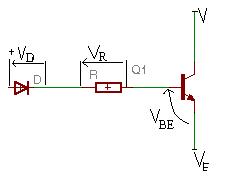simonwai999
Advanced Member level 4
Re: base resistance
hi, folks.
I would like to know why the resistor for the base of 2n3053 is 330 ohms
how do we calculater it ?
Here is what I think:
in a transistor
ic=ie
hfe = ic/ib
ib= ic/hfe
since ie approximately equals to ic
let ie be 300ma and hfe be 100
ib = ie( 300ma)/hfe( 100)=3ma
let's assume pin 1,2,3,4,5,,7 and 10 output of cd4017 = 3 volts
the resistance for the base of the transistor 2n3053 will be
R= 3/3mA
R=1000
we devide 1000 by 3 to let the transistor saturate
so the R for the transistor base is around 330 ohm
Am I correct?
When it comes to calculating the base of R of a transistor,
i am confused
Please correct me if i am right
thanks so much
Added after 3 minutes:
here is the circuit
hi, folks.
I would like to know why the resistor for the base of 2n3053 is 330 ohms
how do we calculater it ?
Here is what I think:
in a transistor
ic=ie
hfe = ic/ib
ib= ic/hfe
since ie approximately equals to ic
let ie be 300ma and hfe be 100
ib = ie( 300ma)/hfe( 100)=3ma
let's assume pin 1,2,3,4,5,,7 and 10 output of cd4017 = 3 volts
the resistance for the base of the transistor 2n3053 will be
R= 3/3mA
R=1000
we devide 1000 by 3 to let the transistor saturate
so the R for the transistor base is around 330 ohm
Am I correct?
When it comes to calculating the base of R of a transistor,
i am confused
Please correct me if i am right
thanks so much
Added after 3 minutes:
here is the circuit
